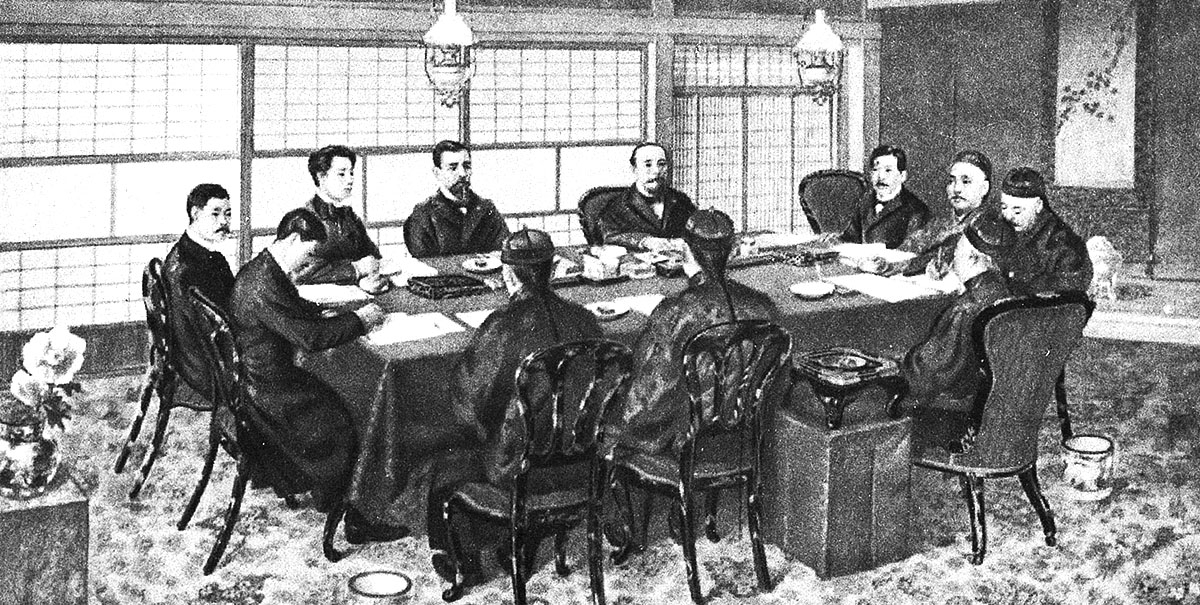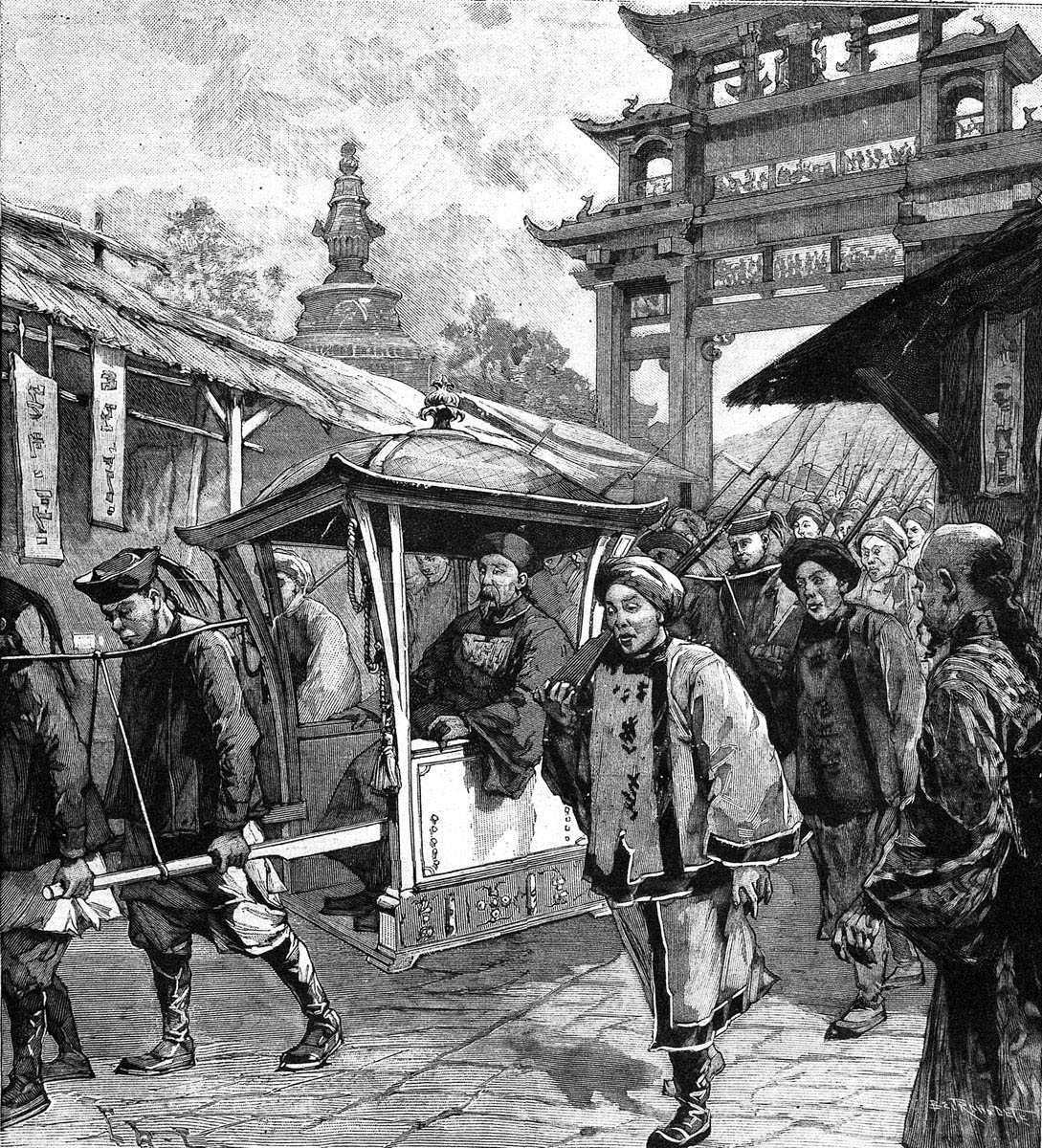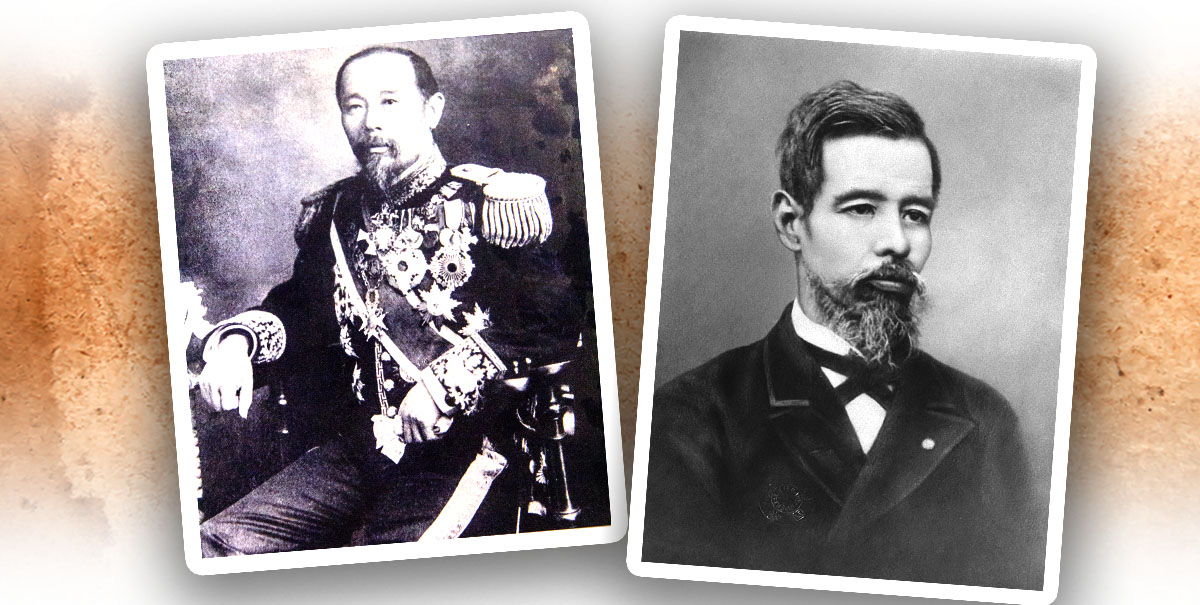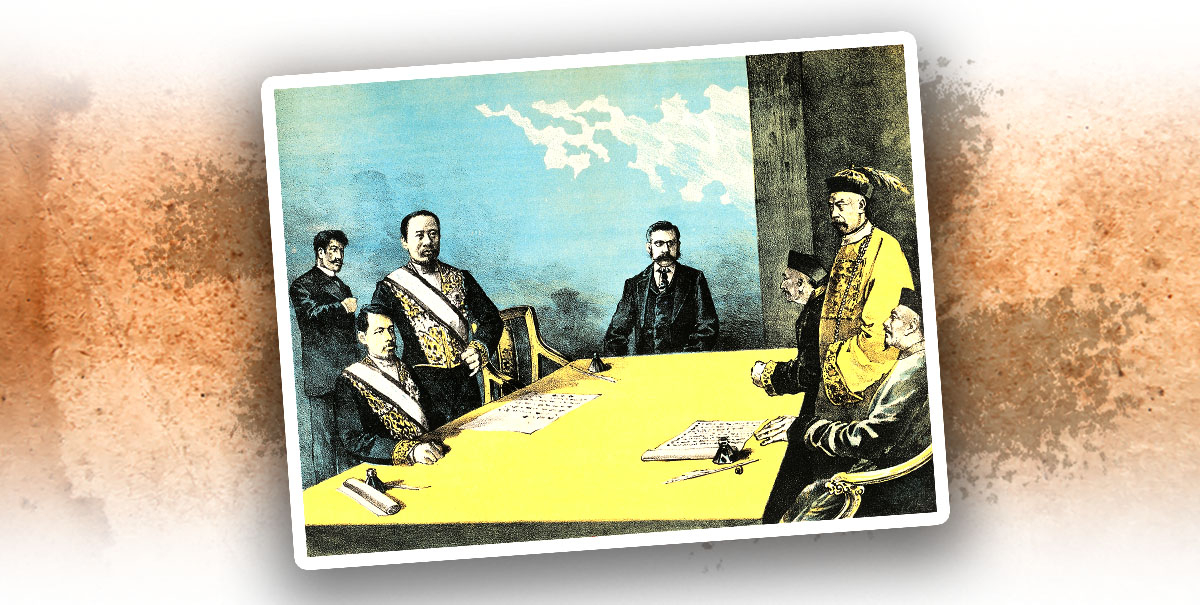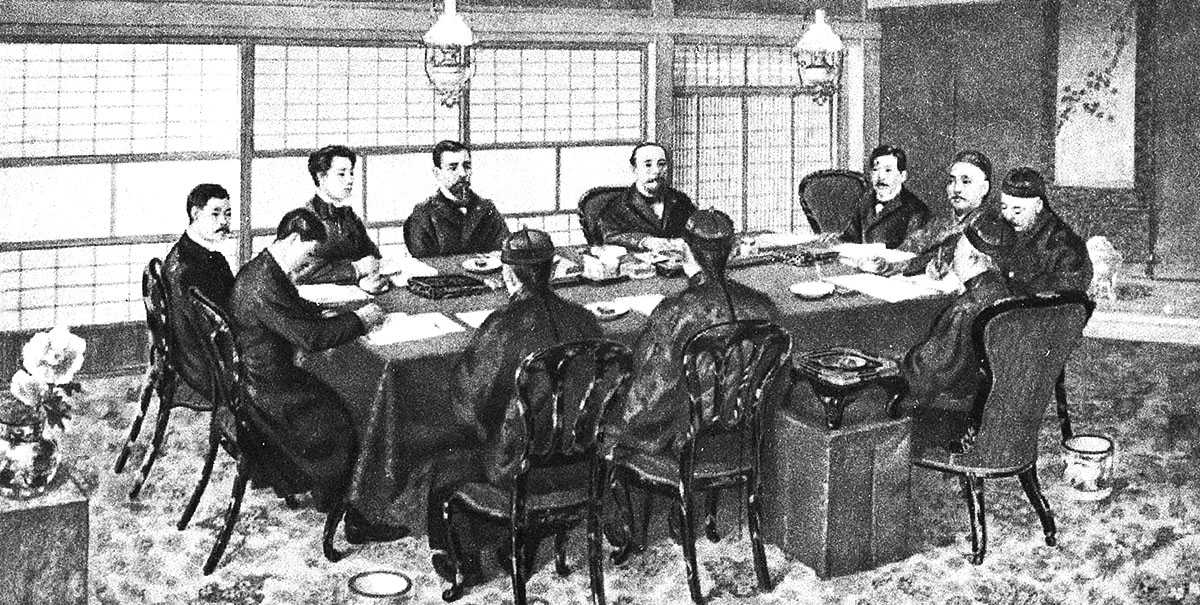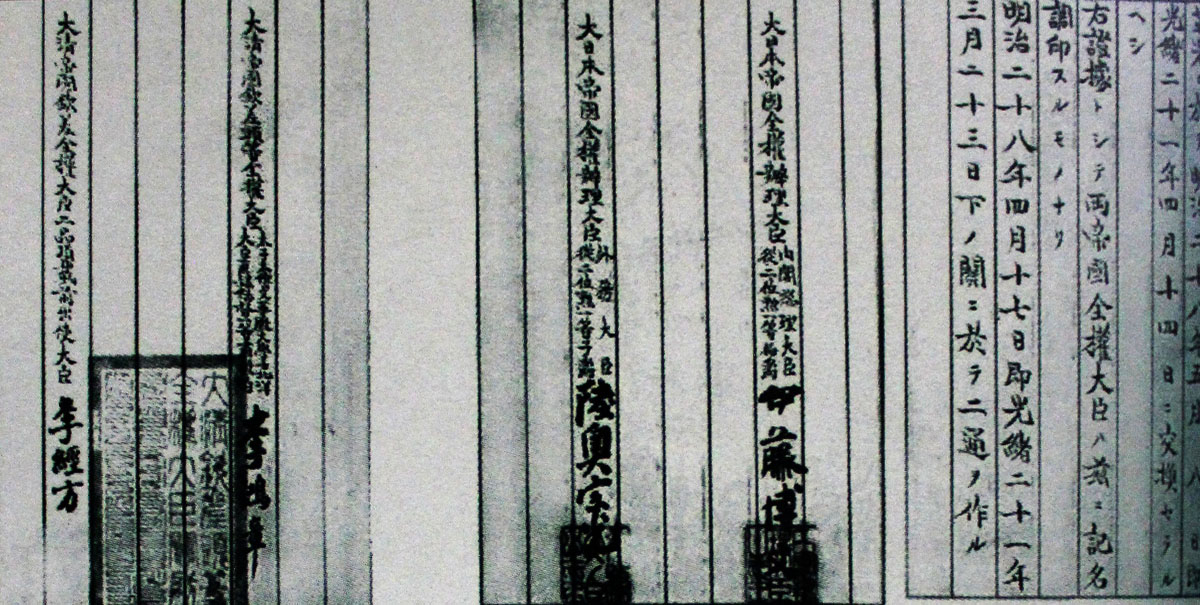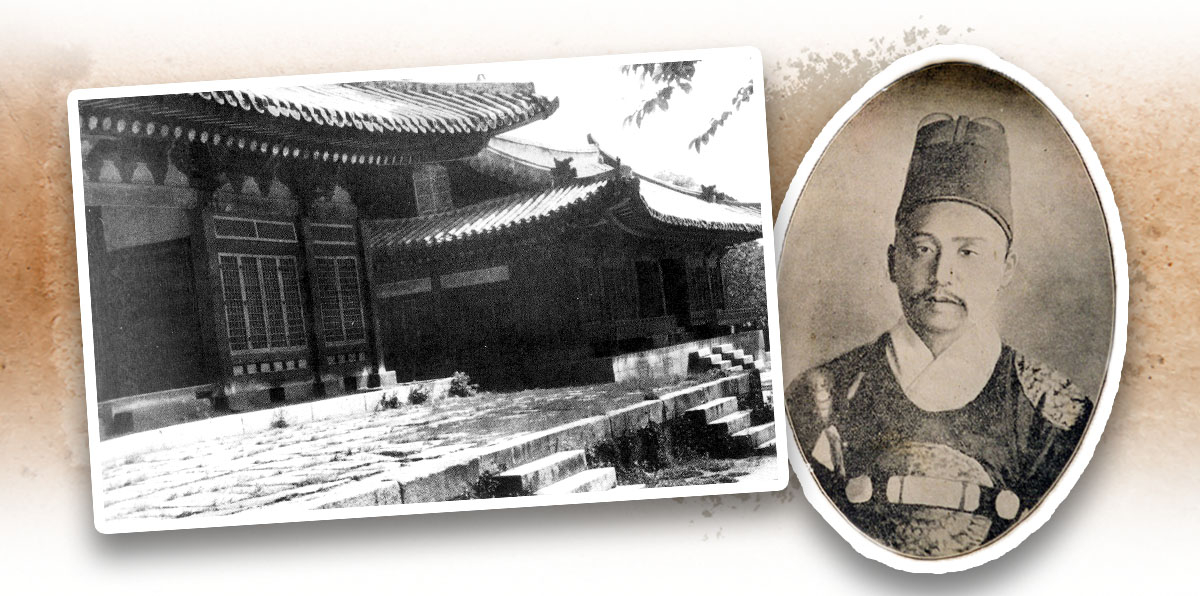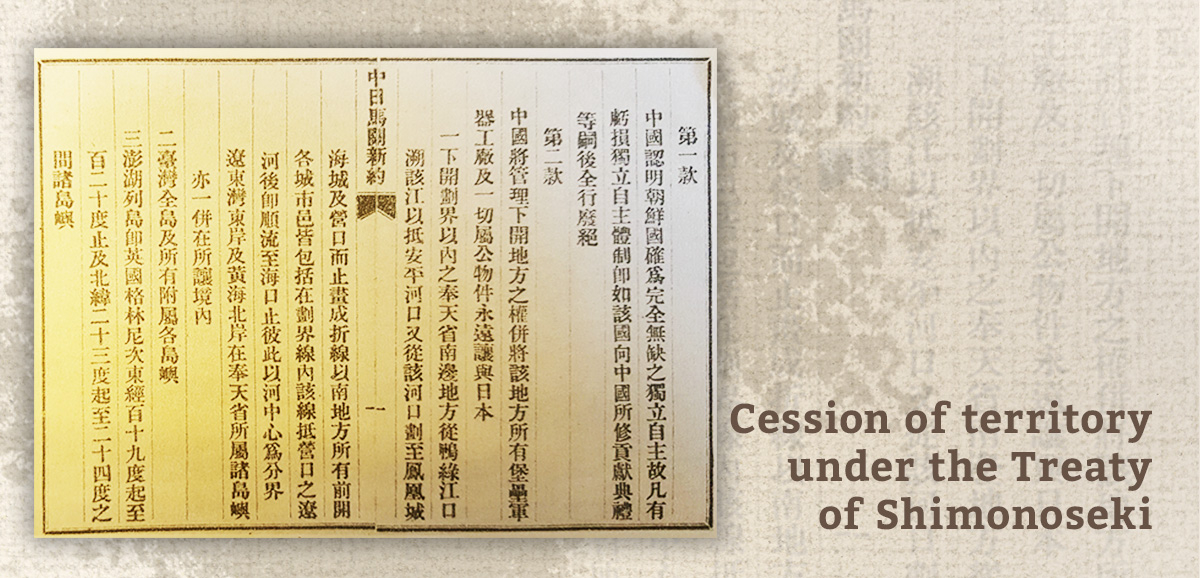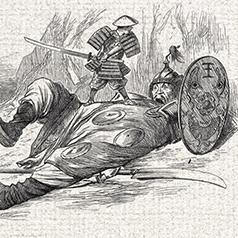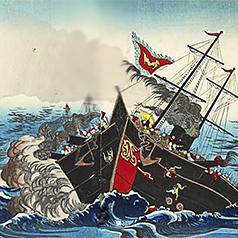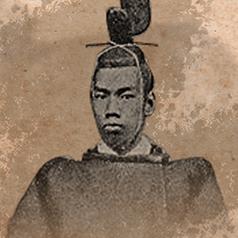From the onset of the First Sino-Japanese War senior Chinese officials, including Li Hongzhang (李鴻章) under Empress Dowager Cixi (慈禧太后), were never truly committed to fighting the Japanese. After losing the battles in Pyongyang and the Yellow Sea, the Qing government became more indecisive and sought the help of foreign powers. In March 1895, Li Hongzhang was sent as an envoy to meet with Japanese Prime Minister Itō Hirobumi and Foreign Minister Mutsu Munemitsu in Shimonoseki, Japan for official peace negotiations.
The Treaty of Shimonoseki was signed on April 17. The terms included: 1) China would recognize the autonomy of Korea; 2) China would cede Liaodong Peninsula (遼東半島, which China bought back for 30,000,000 silver dollars after Russia, Germany and France intervened), Taiwan (台灣) and the Penghu Islands (澎湖列島); 3) China would pay 200,000,000 silver dollars in war indemnity and open the ports of Shashi (沙市), Chongqing (重慶), Suzhou (蘇州) and Hangzhou (杭州) to Japan; 4) China would grant Japanese merchants favored status so they could import machinery, manufacture and set up a tax-free inventory in these trade ports; and 5) China would allow Japanese military occupation of Weihaiwei (威海衛). From China’s perspective, it was the ultimate national humiliation and a deeply shameful loss of sovereignty. Additionally, by allowing Japanese factories to operate in China, imports of foreign goods became imports of foreign capital.
|
|
Why is the Treaty of Shimonoseki regarded as the most humiliating act and shameful loss of sovereignty forced upon China in the late 19th century? |
|
|
See answer below. |
Defeated soundly both on land and at sea, the Qing court was forced to send Li Hongzhang to Japan to sue for peace. The picture
shows Li Hongzhang departing Beijing in March 1895 for the voyage to Japan.
Key Japanese representatives at the negotiation: Prime Minister Itō Hirobumi and Foreign Minister Mutsu Munemitsu.
On March 21, 1895, negotiations commenced at Shimonoseki, Japan. The peace treaty imposed harsh terms on China, which had no bargaining power in the wake of its devastating defeat.
On April 17, 1895, representatives of China and Japan signed the Treaty of Shimonoseki at Shunpanrō Hotel in Shimonoseki, Japan. In the picture, Li Hongzhang is sitting on the right of the brazier, opposite Itō Hirobumi. Mutsu Munemitsu is on the right of Itō Hirobumi.
Signatures of China and Japan’s representatives on the Treaty of Shimonoseki: (from right) Itō Hirobumi, Mutsu Munemitsu, Li Hongzhang, Li Jingfang (李經方, Li Hongzhang’s nephew and later adopted son).
Modern-day Shunpanrō Hotel in Shimonoseki, Japan. Shunpanrō Hotel stood witness to the Sino-Japanese negotiations and the subsequent signing of the Treaty of Shimonoseki. The Treaty of Shimonoseki consisted of 11 articles which obliged China to cede land, pay an indemnity and open ports for trade with Japan, among other concessions.
Deoksu Palace in Korea and King Gojong of the Korean Joseon dynasty. The First Sino-Japanese War broke out during the reign of Gojong who was the 26th king of the Korean Joseon dynasty. The first article of the Treaty of Shimonoseki asserts: “China recognizes definitively the full and complete independence and autonomy of Korea.” In effect, it severed the China-Korea tributary relationship and allowed Japan to control Korea.
After defeating China, Japan lost no time in strengthening its control over Korea, yet was met with continued resistance from the Korean people. In 1909, Itō Hirobumi, one of the founding fathers of the Meiji Era and the first Japanese Resident-General of Korea in charge of Korean affairs, was assassinated by Korean nationalist An Jung-geun. In 1910, Japan officially annexed Korea. On January 22, 1919, Korean ruler Gojong died suddenly and was widely believed to have been poisoned by Japanese officials, prompting public outrage. On March 1, multitudes gathered to mourn Gojong and demand independence. The outcry soon spread to the rest of Korea, and grew into anti-Japanese demonstrations and armed uprisings involving over 2,000,000 people. These were ultimately suppressed by the Japanese. This was later known as the March 1st Movement. Today, March 1 is an annual day of commemoration in honor of this nationalist movement.
In accordance with Article Two of the Treaty of Shimonoseki, China ceded to Japan the Liaodong Peninsula, Taiwan and associated islands and the Penghu Islands.
Concerned that Japan’s acquisition of Liaodong Peninsula would affect Russian interests in northeastern China, Russia persuaded France and Germany to intervene. Together, they pressured Japan into returning the territory to China in exchange for an additional indemnity of 30,000,000 silver dollars from China. Later known as the Triple Intervention, this exacerbated the clash of Japanese and Russian interests in northeastern China and Korea, and laid the groundwork for the Russo-Japanese War from 1904 to 1905.
According to the first line of Article Four of the Treaty of Shimonoseki, China was obliged to pay Japan 200,000,000 silver dollars in war indemnity, an amount that far exceeded the total reparations paid under all the unequal treaties since the Opium War.
Initially, Japan insisted on the payment of 300,000,000 silver dollars in reparations. During Li Hongzhang’s stay in Japan to negotiate the treaty, he was shot in the face in an assassination attempt. Fortunately, the 73-year-old envoy survived the ordeal. Catching sight of his bloodied garments, he knew his misfortune would enable him to leverage concessions from Japan. “This blood has been shed to China’s benefit,” he said with feeling.
Indeed, embarrassed by the incident and seeing international opinion turn against them, Japan agreed to a minor concession by reducing the amount of reparations to 200,000,000 silver dollars. In total, China paid Japan 230,000,000 silver dollars for war reparations and the redemption of Liaodong Peninsula.
The Treaty of Shimonoseki forced China to open the ports of Shashi, Chongqing, Suzhou and Hangzhou to trade with Japan, in addition to granting economic privileges to the Japanese.
|
|
Why is the Treaty of Shimonoseki regarded as the most humiliating act and shameful loss of sovereignty forced upon China in the late 19th century? |
|
|
The Treaty of Shimonoseki was excessively harsh. China had to cede a large island chain (Taiwan and Penghu Islands) and pay large sums in war reparation, in addition to allowing special Japanese access at various ports and an influx of foreign capital. Gradually, China not only became an exporter of raw material and an importer of foreign goods as well as capital, but also a domestic market of products made by foreign businesses with locally-sourced materials and labor. In essence, sanctioning foreign control in manufacturing, mining and logistics, impeded China’s own development of industrial capacity. |
Source of most photos used in this feature piece: Fotoe (pictures 1, 2, 4-7), Visual China Group (picture 3), misc. photo sources.




